The Straits of Messina

Turbulent water of the Strait of Messina
How could the Strait of Messina not hold allure? Whirlpools and maelstroms; mythic sea monsters; earthquakes and epic sea currents!
To get to Greece and Turkey from Italy where we’d been sailing for the last month, your either transit the Strait of Messina, or sail all the way around Sicily, the second biggest island in the Mediterranean. For us, it was a no-brainer: the Strait was something we’d been looking forward to experiencing.
The Strait is special on a number of levels. For one thing, it’s a challenging body of water (like New York’s East River “Hell Gate” that we navigated in 2014) legendary for its turbulence, internal wave collapse and coastal currents.
Geography of the Strait
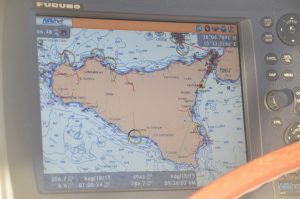
the island of Sicily with the Strait of Messina at the top, right, as seen on our Furuno navigation screen
The Strait of Messina separates the Peninsula of Italy from Sicily and is the connection between the Tyrrenhian Sea and the Ionian Sea. It is a 20 mile long, narrow passage measuring between 1.9 miles to 3.2 miles in width. Geologically, this area is unstable and has had many earthquakes, including one in 1908 that measured 7.5 on the Richter scale and was followed by a 40′ high tsunami.
The sea bottom is 300-600 deep at the north end, then it slopes down to approximately 1,300 meters near the southern end at the Ionian Sea. As the sea floor drops and the winds flow against the direction of powerful tidal currents, they form what is sometimes called a maelstrom, which is like a spinning underwater tornado. It’s not as dangerous as it sounds, but choppy seas and rotating whirlpools can still overturn small boats and the rough, broken swells can cause navigational hazards for larger ones. You definitely feel the whirlpools tug when they catch you near the northern end of the Strait where the southern tip of Calabria faces the eastern tip of Sicily.
Rich Biodiversity
The water in the strait is a mixture of the two seas; at the narrowest point of the Strait, the surface water is of Atlantic origin, from the Tyrrenhian, and underneath is the Levantine Ionian water, which is much colder. The intense, alternate currents in the Strait, combined with the temperature variations, create a bubbly soup of nitrogen and phosphorus coming up to the surface from the deep water, which results in a “Paradise for the Zoologist” of the enormous biodiversity. With its particular location and shape, the Strait is also a popular point of transit in the migration of many bird species.
Currents
The length of time it takes to transit it is more a function of the currents than the distance. When going from South to North (the opposite way as we traveled on our Antares catamaran Golden Glow), the current usually runs around 2 knots. But the currents change direction every six hours and the vary in intensity from day to day, hour to hour. We had carefully checked tides and currents before starting out, looking for the most favorable window when the opposite currents impede our forward momentum to the smallest degree possible. This called for a passage that began at about midnight, but gave us a beautiful dawn as we reached the end of the Strait.
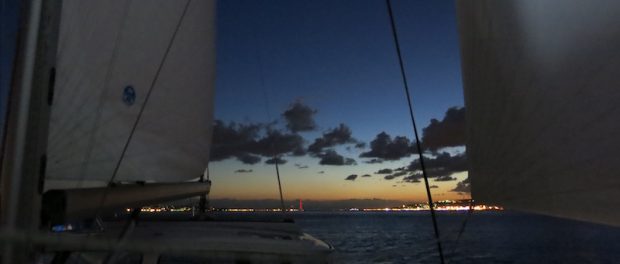
Dawn breaking
Navigation
Another danger in the Strait is boat traffic. Not only are many boats heading north and south 24 hours a day, numerous ferries also zip back and forth between Sicily and the mainland across the sea lanes. It is a busy body of water that requires attentiveness at all times.
Strait of Messina in Literature
Another allure of the Strait of Messina is what we’ve read about it in literature. Shakespeare’s Much Ado About Nothing and Homer’s Odyssey are both set in Messina, and I wanted to see how reality compared to my imagination.
Homer wrote about Odysseus’ hazardous sea voyage where he encountered two immortal creatures called Scylla and Charybdis on opposite sides of the Strait. Scylla was a six-headed sea monster made from jealousy and betrayal that was the rock shoal on the mainland side of the strait. She devoured innocent sailors that crashed into her rocks. To make matters worse, beautiful sirens, half woman, half bird, were supposed to inhabit an island near Scylla. They had irresistible voices and would call to the sailors, luring them off their course to be dashed on the rocks below.Charybdis was the personification of the whirlpool off the coast of Sicily.
Both sea hazards were located close enough to each other that they posed an inescapable threat to passing sailors; avoiding Charybdis meant passing too close to Scylla and vice versa. Like Odysseus, we had to chose which danger to get closer to as we sailed through the strait. He opted to pass by Scylla and lose only a few sailors, rather than risk the loss of his entire ship in the whirlpool. With the benefit of our engines if we needed them, we opted to stay away from the rocks and go closer to the whirlpool, and we didn’t lose any sailors or our boat thankfully.
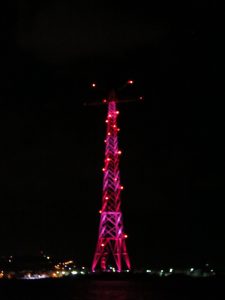
one of the 761 feet high color-changing electric Pylons of Messina
Having survived the whirlpools, currents, mythical creatures, we passed out of the Strait and on to the west, where we would spend some time in Taormina Sicily before heading on to Greece.
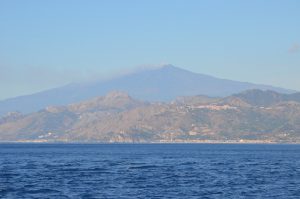
Steam erupting from Sicily’s Mt. Etna, the largest active volcano in Europe
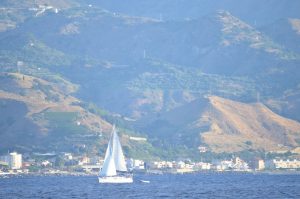
off the coast of Taormina Sicily

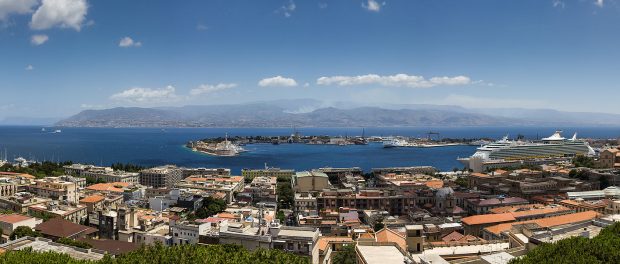






Leave a comment